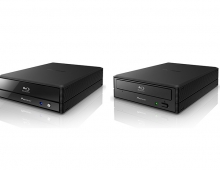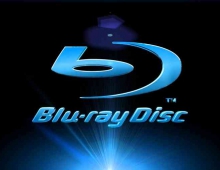
Blu-ray Disc Ready for Cost Effective Manufacturing
Broad acceptance and adoption of Blu-ray Disc has led to the maturation of the complete disc manufacturing process.
Having multiple companies involved with each step has contributed to process improvements and cost efficiencies that bring the long-term cost of manufacturing BD-ROM discs in line with current DVD replication costs.
"There are a lot of companies trying to stake out a position in various aspects of BD-ROM manufacturing," said Kazuhiro Tsuga, executive officer of Matsushita Electric. "As a result, we are seeing multitudes of improvements in processes and technology, as well as the effects of economies of scale that make replication extremely cost effective."
The most recent advances come in the area of cover-layer technology, where one of two approaches (film bonding and spin coating) can be used to apply the 0.1mm cover-layer used in Blu-ray Disc.
The spin-coating process, which uses resin to form the cover-layer, is now being piloted in Torrance, California by Panasonic, who in cooperation with Origin Electric, has developed replication technology and equipment for the mass production of spin-coated discs.
In film bonding, the development of new extruded film technology by several leaders in the chemical industry has significantly reduced film costs. A new film product from Teijin reduces the cost of the cover film to one-third of the cost of conventional polycarbonate materials, and Degussa, a new BDA member company, projects a single-digit Euro cents per-disc cost at launch. In addition to these advances in film materials, Lintec Corporation's hard coat material and film bonding process makes the film bonding method very efficient.
With the improvements in cover-layer technology, and in preparation for mass production of BD-ROM discs, Singulus Technologies, a leading manufacturer of replication equipment, has developed replication systems that will target cycle times towards three seconds. Yields are expected to exceed 90% in a full-scale, mass production environment.
Sony has developed equipment to streamline the disc mastering process by reducing the eleven steps currently used in DVD mastering to five for BD-ROM. This mastering process, Phase Transition Mastering (PTM), requires as little as one-fifth of the space required for DVD mastering and the equipment can be configured to allow mastering of both BD-ROM and DVD-ROM on a single system. The first two commercial machines are for Technicolor and Cinram for Q2, 2005 installation.
With these developments in the industry, replication facilities in the United States are setting up and preparing to mass produce BD-ROM Discs. Technicolor is establishing a complete pilot BD disc manufacturing process by July 2005. Cinram already has a pilot replication line that produced demo discs for CES 2005 and is awaiting the delivery of commercial lines.
"Fox is pleased to see the increasing number of technology companies and materials vendors committing to Blu-ray implementation, which is reducing costs to promising levels through technological breakthroughs and innovation," said Danny Kaye, SVP Technology and Research Strategy at Twentieth Century Fox. "We look forward to continued technological progress along with developments in content protection."
In addition to ramping up for mass production of the 50GB discs that will be available at format launch, Blu-ray has begun work to ensure that the format continues to grow as high-definition technology evolves. Blu-ray companies have successfully demonstrated 200GB discs in a laboratory environment and are poised to further expand the format's capacity as needs dictate.
"There are a lot of companies trying to stake out a position in various aspects of BD-ROM manufacturing," said Kazuhiro Tsuga, executive officer of Matsushita Electric. "As a result, we are seeing multitudes of improvements in processes and technology, as well as the effects of economies of scale that make replication extremely cost effective."
The most recent advances come in the area of cover-layer technology, where one of two approaches (film bonding and spin coating) can be used to apply the 0.1mm cover-layer used in Blu-ray Disc.
The spin-coating process, which uses resin to form the cover-layer, is now being piloted in Torrance, California by Panasonic, who in cooperation with Origin Electric, has developed replication technology and equipment for the mass production of spin-coated discs.
In film bonding, the development of new extruded film technology by several leaders in the chemical industry has significantly reduced film costs. A new film product from Teijin reduces the cost of the cover film to one-third of the cost of conventional polycarbonate materials, and Degussa, a new BDA member company, projects a single-digit Euro cents per-disc cost at launch. In addition to these advances in film materials, Lintec Corporation's hard coat material and film bonding process makes the film bonding method very efficient.
With the improvements in cover-layer technology, and in preparation for mass production of BD-ROM discs, Singulus Technologies, a leading manufacturer of replication equipment, has developed replication systems that will target cycle times towards three seconds. Yields are expected to exceed 90% in a full-scale, mass production environment.
Sony has developed equipment to streamline the disc mastering process by reducing the eleven steps currently used in DVD mastering to five for BD-ROM. This mastering process, Phase Transition Mastering (PTM), requires as little as one-fifth of the space required for DVD mastering and the equipment can be configured to allow mastering of both BD-ROM and DVD-ROM on a single system. The first two commercial machines are for Technicolor and Cinram for Q2, 2005 installation.
With these developments in the industry, replication facilities in the United States are setting up and preparing to mass produce BD-ROM Discs. Technicolor is establishing a complete pilot BD disc manufacturing process by July 2005. Cinram already has a pilot replication line that produced demo discs for CES 2005 and is awaiting the delivery of commercial lines.
"Fox is pleased to see the increasing number of technology companies and materials vendors committing to Blu-ray implementation, which is reducing costs to promising levels through technological breakthroughs and innovation," said Danny Kaye, SVP Technology and Research Strategy at Twentieth Century Fox. "We look forward to continued technological progress along with developments in content protection."
In addition to ramping up for mass production of the 50GB discs that will be available at format launch, Blu-ray has begun work to ensure that the format continues to grow as high-definition technology evolves. Blu-ray companies have successfully demonstrated 200GB discs in a laboratory environment and are poised to further expand the format's capacity as needs dictate.





















